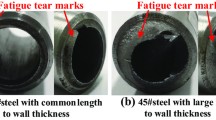Abstract
The crack initiation and propagation at the surface defect of coiled tubing (CT) are easily caused by stress concentration, which leads to failure of CT. To explore the critical load and its influencing factors for crack initiation of CT with spherical defect, based on the maximum principal stress criterion and damage evolution criterion, the extended finite element method is applied. In this paper, the ABAQUS software is used to establish a CT model with spherical defects, and to study the crack initiation and propagation of the CT with spherical defects under the combined loads of tensile load, internal pressure, and bending displacement. The results show that the critical tensile load for crack initiation is 274.5 kN, the critical bending displacement is 86.6mm, and the critical internal pressure load is 88.8 MPa at the stage of crack initiation at a spherical defect with a radius of 2 mm. Meanwhile, in the crack propagation stage, the crack length under 430 kN tensile load is 97.8 mm, the crack length under 145 MPa internal pressure is 161.8 mm, and the crack length under 120 mm bending displacement is 130.4 mm. The research results provide a reference for judging whether the CT with defect can continue to be used, and lay a foundation for the formulation of the standard for the use of CT with defect.










Similar content being viewed by others
References
Z. Shen, H. Huang, D. Gao, New progress and development trend of world drilling technology. J. China Univ. Pet. Ed. Nat. Sci. 33(04), 64–70 (2009)
Z. Tang, Z. Liu, J. Xiong, A review of coiled tubing drilling techniques. Nat. Gas Ind. 8, 73–75 (2005)
W.P. van Adrichem, H.A. Larsen, Coiled-tubing failure statistics used to develop CT performance indicators. SPE Drill. Complet. 17(03), 159–163 (2002)
R. Zhao, J. Zheng, Q. Wang, Q. Yuan, S. Zhao, Y.J. Liu, J. Plast Eng. 25(01), 276–282 (2018). ((in Chinese))
G.L. Golewski, P. Golewski, T. Sadowski, Numerical modelling crack propagation under Mode II fracture in plain concretes containing siliceous fly-ash additive using XFEM method. Comput. Mater. Sci. 62, 75–78 (2012)
Q. Meng, Z. Wang, Extended finite element method for power-law creep crack growth. Eng. Fract. Mech. 127, 148–160 (2014)
S. Kumar, A.S. Shedbale, I.V. Singh, B.K. Mishra, Elasto-plastic fatigue crack growth analysis of plane problems in the presence of flaws using XFEM. Front. Struct. Civ. Eng. 9(4), 420–440 (2015)
L. Xu, Q. Wang, M. Zhou, Micro-crack initiation and propagation in a high strength aluminum alloy during very high cycle fatigue. Mater. Sci. Eng. A. 715, 404–413 (2018)
Q. Deng, X. Yin, M.A. Wahab, The effect of surface pit treatment on fretting fatigue crack initiation. Comput. Mater. Contin. 66(1), 659–673 (2021)
J. Duan, F. Sui, H. Liu, F. Jie, T. Ou, R. Bao, Fatigue crack growth of thin-walled structures under bending load. Acta Aeronautica et Astronautica Sinica. 42(5), 524326 (2021). (in Chinese)
C. Guo, P. Li, X. Jiang, Z. Hu, L. Sun, Press. Vessel. 02, 3–9 (1999)
Y.J. Kim, D.J. Shim, N.S. Huh, Y.J. Kim, Plastic limit pressures for cracked pipes using finite element limit analyses. Int. J. Press. Vessels Pip. 79(5), 321–330 (2002)
Y.J. Kim, D.J. Shim, K. Nikbin, Y.J. Kim, S.S. Hwang, J.S. Kim, Finite element based plastic limit loads for cylinders with part-through surface cracks under combined loading. Int. J. Press. Vessels Pip. 80(7), 527–540 (2003)
J. Shi, Z. Jiang, D. Xiang et al., Research on crack growth of coiled tubing steel based on extended finite element method. China Pet. Mach. 47(11), 104–110 (2019)
J. Zhu, X. L, Fatigue characteristics and fracture analysis of CT80 coiled tubing. Hot Work. Technol. 47(10), 259–262 (2018)
Z. Bi, X. Zhang, W. Zhang, Experimental study on fatigue life of coiled tubing. Welded Tubing. 35(06), 5–8 (2012)
G.U.A.N. Feng, W.A.N.G. Zhen, L.I.U. Shaohu et al., Finite element analysis of stress intensity factor for coiled tubing composite crack. China Saf. Sci. Technol. 14(10), 76–81 (2018)
L. Shaohu, W. Yuandeng, Z. Hao, Critical ultimate load and ultimate bearing failure of CT110 with initial crack defect. J. Fail. Anal. Prevent. 21(1), 204–212 (2021)
L. Shaohu, Z. Hao, Z. Hong, L. Yang, W. Zhen, Experimental and numerical simulation study on fatigue life of coiled tubing with typical defects. J. Pet. Sci. Eng. 198, 108212 (2021)
R. Zhao, H. Li, Y. Jiang et al., Fatigue crack initiation and short crack propagation of GH4133B alloy used in aeroengine turbine disc. J. Mech. Eng. 49(10), 116–126 (2013)
M.D. Sangid, The physics of fatigue crack initiation. Int. J. Fatigue. 57, 58–72 (2013)
M. Schöllmann, H.A. Richard, G. Kullmer, M. Fulland, A new criterion for the prediction of crack development in multiaxially loaded structures. Int. J. Fract. 117(2), 129–141 (2002)
L. Wen, R. Tian, Improved XFEM: Accurate and robust dynamic crack growth simulation. Comput. Methods Appl. Mech. Eng. 308, 256–285 (2016)
Z. Bi, L. Xian, H. Wang et al., Microstructure and properties of domestic ultra-high strength CT110. Welded Tubing. 40(03), 24–27 (2017)
A. Ustrzycka, Z. Mróz, Z.L. Kowalewski, S. Kucharski, Analysis of fatigue crack initiation in cyclic microplasticity regime. Int. J. Fatigue. 131, 105342 (2020)
Acknowledgments
This research was supported by the Natural Science Foundation of China (Nos. 51974036, 51604039), the Hubei Provincial Outstanding Young and middle-aged Science and Technology Innovation Team Project (No. T2021035) and the Young Top-notch Talent Cultivation Program of Hubei Province.
Author information
Authors and Affiliations
Corresponding author
Ethics declarations
Conflict of interest
The authors declare that they have no conflict of interest.
Additional information
Publisher's Note
Springer Nature remains neutral with regard to jurisdictional claims in published maps and institutional affiliations.
Rights and permissions
About this article
Cite this article
Yang, Y., Shaohu, L. Study on Natural Crack Initiation and Propagation of Coiled Tubing with Spherical Defect. J Fail. Anal. and Preven. 22, 648–657 (2022). https://doi.org/10.1007/s11668-022-01352-6
Received:
Revised:
Accepted:
Published:
Issue Date:
DOI: https://doi.org/10.1007/s11668-022-01352-6




